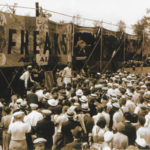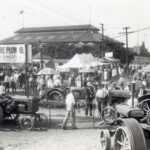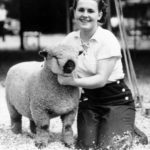The American State Fair
Who can forget their first visit to the fair — a magical land of sights and sounds and smells beyond the reach of teachers, bosses, worries, and chores? There is nothing quite like that strange, veritable city that rises anew year after year on the outskirts of town to fill youths with wide-eyed wonder and adults with vivid memories of their own childhoods. For many people and many generations, the fair has occupied its own special place on the calendar and in the heart.
The American state fair is a conceptual curiosity, a celebration of agriculture that is at once a fantastic departure from the discipline and labor of the farming life. Even at the earliest fairs, agricultural displays and discussions competed for space and attention with horse races, carnivals, and shows. And innovations only widened the gap. The plowing contest became the tractor pull, and the horse race led to auto and motorcycle races and automobile stunt shows. Horse and hog contests blossomed into competitions among every kind of animal and vegetable, with baking and sewing contests right alongside. Like the prizewinning livestock and produce they showcased, state fairs expanded in size and number, becoming a national institution.
Agricultural fairs reach back to biblical times and promise to stretch far into the future. In America it was around the time of the Civil War when many of the country’s best-known and largest state fairs were first held. Before that, fairs were mostly local or county-wide affairs, more serious and less entertaining. But after the Civil War, the thrill shows, contests, and pageants that became such an integral part of our fair experience appeared to enliven the event.
The farming community began to shrink after World War I — a trend that accelerated after World War II. At the time of the Civil War, the vast majority of Americans supported themselves through agriculture; by 1940, only a quarter of all Americans lived on farms, and by 1980, that number was down to three of every hundred. Rural America was disappearing, and although fairs were thriving, the crowds in attendance were more often city or suburban dwellers who saw livestock about as often as they saw animals in zoos.
Fairs have changed with the people who have sponsored them, but tradition and innovation remain constant. In the 1860s and 1870s, fairs closed at dusk because gaslights and electricity were still decades in the future. Implements from that time, then considered revolutionary, live on in exhibits of agricultural history. By the 1950s, the Texas fair was installing a monorail, and the Indiana fair was displaying a replica of an atomic pile at an exhibit of nuclear energy. But at both fairs, the venerable Ferris wheel, invented at the turn of the century, was still a centerpiece of the midway. New meets old at the fair, and always takes something fresh from the encounter.
A retrospective of state fair snapshots and anecdotes includes a cavalcade of exciting, old, funny, heart-warming, startling, and amazing things. Monkeys dressed in hats danced to minstrel music at the Ohio State Fair in 1853. Monkeys drove miniature hot rods in California in the 1950s (the first aid tent, one year, treated 10 people for monkey bites, along with the usual hundreds of stomachaches and dozens of lost children).
Fairs held butter-making contests. A dairy company presented a butter sculpture of Teddy Roosevelt, posed with his foot on a dead lion; a live lion once rode in a racecar. Elsewhere, a butter sculptor carved a John Deere tractor. Fairs featured tractors when they were newfangled inventions that some farmers figured would never replace horses. Those same tractors appeared at displays of antique farm equipment 100 years later, where they evoked nostalgia for a simpler time.
Sure, fairs are corny — that’s why folks love them. Where else could you see a replica of the Statue of Liberty made of ears of corn? Or the state’s tallest corn stalk? Or watch contestants vie to slice off the longest apple peel? Or see a Liberty Bell made of apples?
Such attractions were irresistible.
Pretty girls wore new styles during fashion shows. Pretty girls in coochie shows wore not much at all. Pretty cows had their own events, as did fat cattle.
You could see the eruption of Mount Vesuvius depicted on a huge mural. The Battle of Manila in fireworks shot high into the night sky. A daredevil shot from a cannon. A car (the Torpedobile) shot from a cannon.
Big shots gave speeches. Trick shots entertained the crowds. Suffragettes rubbed elbows with prohibitionists; bootleggers offered shots of illicit liquor. Bamboozlers thrived. Bamboo novelty canes sold like hotcakes.
Parched fairgoers swilled draft beer and eyed draft horses. Draftees poured into fairgrounds during four wars, turning barns into barracks. One fairground became a prisoner-of-war camp during the Civil War. At another fairground, a huge family campground has been popular for generations.
At fairs from Florida to Alaska, farmers and ranchers have shown enough livestock to fill 10,000 Noah’s arks, and gardeners enough jars of fruits and vegetables to build a pyramid for a pharaoh.
You can see cages of pigeons with names you’ve never heard: Oriental Frills, Modenas, Fantails, Birmingham Rollers, and White Kings.
You could have seen Blue Boy (the prizewinning hog in Phil Stong’s novel State Fair) or Old Oscar (the Iowa State Fair’s famous sturgeon, who spent 28 years as an attraction at the fair before dying in his tank on the last day of the fair in 1954). You can still peer up at Big Tex, the giant robot who greets people (in English and Spanish) at the Texas State Fair.
Honest Abe spoke at the Wisconsin State Fair in 1859 (he was paid $150, which included his expenses). A century later, the Kentucky State Fair held Abraham Lincoln look-alike contests.
Racers galore vied for ribbons, trophies, and loot; events featured horses, mules, camels, burros, dogs, boys, people riding on bikes or riding in wheelbarrows. Ostriches raced. At the World’s Columbian Exposition in Chicago in 1893, an entrepreneur named E. R. Johnson of Fallbrook, California, did a steady business by serving omelets made from the eggs laid by his flock of 28 ostriches.
For generations, Americans took fairs to heart and expanded them in an unprecedented fashion. Along the way, the state fair became a piece of bedrock Americana, with elements so familiar that they seem quintessentially domestic.
The reason for this popularity is that, throughout their sprawling, tumultuous history, state fairs have always reflected the basic elements of the national character: the strengths and weaknesses, the common sense and faddishness, the unities and discords that have long marked Americans’ unique development as a culture.
Gallery
Courtesy: Iowa State Fair/Des Moines
Courtesy: Iowa State Fair/Des Moines
Courtesy: Indiana State Fair Archives
Courtesy: Iowa State Fair/Des Moines
Courtesy J.C. Allen & Son, Inc.
Four-H Fair
August 28, 1948
You may also like:

State Fair State of Mind with 2009 State Fair Directory
Six-hundred-pound buttered cows, walleye-on-a-stick snacks, cow-birthing tents, and alligator wrestling can only mean one thing: It’s state fair season in America.
Reprinted from The American State Fair by Derek Nelson, © Derek Nelson 2003.
State Fair State of Mind
Six-hundred-pound buttered cows, walleye-on-a-stick snacks, cow-birthing tents, and alligator wrestling can only mean one thing: It’s state fair season in America.
Ever since a New England farmer by the name of Elkanah Watson organized an exhibition of sheep under an elm tree in Pittsfield, Massachusetts, in 1807, fairs have been drawing throngs to this generation-binding celebration of history, agriculture, and above all, Americana.
“It’s about tradition,” says photojournalist Arthur Grace who crisscrossed the country documenting the annual rite in photographs for his book, State Fair. And, of course, it’s about having a great time. “People leave their troubles at the gate. Once they pass into the entrance of a state fair, you see smiles come over their faces. It can be a magical place,” Grace says.
Oldest, biggest, quirkiest—each state clamors for its own superlative. In the showdown of hoedowns, here are seven to put on your calendar.
Indiana
Some fairs are cutting back, but not Indiana’s. The state is swinging open the gates for an extra five days this year and welcoming musical powerhouses such as Keith Urban and Kelly Clarkson, along with homegrown Hoosier entertainment. Homegrown is what it’s all about, from the nationally known livestock shows to a new Indiana Space Travels exhibition commemorating local contributions to America’s space exploration. Inside tip: Get an early start August 14 for the world’s largest drive-through breakfast.
Minnesota
The Minnesota fair is tightly woven into the fabric of the state’s history—and has its place in American history, too. Teddy Roosevelt delivered his “Speak Softly and Carry A Big Stick” speech at the fair in 1901. And native son F. Scott Fitzgerald wrote about its “tumultuous Midway” and “aeroplanes that really left the ground” in his short story, A Night at the Fair, published in The Saturday Evening Post magazine in 1928. Today, livestock exhibitors and handicrafters still vie for coveted ribbons, and the art of overindulgence is in full swing. Haute cuisine is anything on a stick—from macaroni & cheese and alligator meat to scotch eggs and walleye—the state fish.
Iowa
More than a million people are expected to meet and mingle in this annual salute to the state’s best in agriculture, industry, entertainment, and achievement. Among Iowa’s boasts? It’s the only state fair included in the bestseller 1,000 Places to See Before You Die, and the inspiration behind Rodgers and Hammerstein’s Broadway musical State Fair. The life-size butter cow is here in all its creamery glory. Ditto the Double Ferris Wheel and one of the biggest livestock shows on the planet.
New York
Despite the metropolis 250 miles south of the fairgrounds, the Great New York State Fair at Syracuse is a reminder that agriculture remains vital to the state’s economy. The fair honors traditional music and homespun skills such as woodworking, spinning, and weaving. Returning favorites include Sky Pirates aerialists, the Harlem Wizards stunt basketball team, and chain saw sculptors, joined this year by extreme wakeboard demonstrations. And for the first time ever, business mixes with pleasure with a job fair featuring firms from across the state. Over 21? Don’t miss a taste of New York state wine slushies.
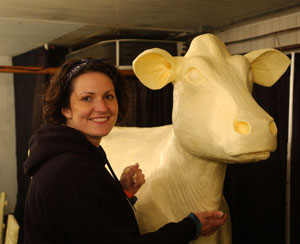
Courtesy: Iowa State Fair
Ohio
In this ode to all things Ohio, it’s about extremes, and that’s the fun of it. Fair veterans will get a first look at new attractions like the BMX Pros Bike and Board Trick Team, the fastest knitting competition, and sunflower seed distance spitting. And those who have their eye on the prize are always in good company. Last year’s fair drew more than 34,000 entries in open and junior competitions. Many relived the experience by sharing their favorite highlights on the Ohio State Fair Web site’s Memory Wall.
California
Since the first state fair in 1854, California’s big bash has been a showcase of Golden State history—but it’s not all about the past. It’s also about the here and now, which is why you might find graffiti art competitions, surf culture exhibitions, and multicultural presentations. This year’s theme is “Weird, Wild and Wacky,” and Californians are getting in on the act by contributing their oddest collections. Among them? Baby teeth, hotel soaps, and PEZ dispensers.
Texas
Everything about the State Fair of Texas is oversized, from its 52-foot iconic cowboy, “Big Tex,” welcoming visitors with a familiar “Howdy, folks” to its sky-high Ferris wheel, one of the tallest in North America. The fair, at 24 days, is also the longest one in the country. And you may need that time to experience it all. The fair is home to the great Red River Rivalry—the Texas versus Oklahoma University college football game—a 300,000-square-foot auto show with a history dating back more than 100 years and all the corn dogs you can eat.
Giving Back
State fairs are about good times—and good causes. This year, at least 10 college-bound students will each win a $2,500 scholarship, courtesy of the Oklahoma State Fair. The State Fair of Virginia awards scholarships to youths in 29 competition areas. And over the last 20 years, over 2,050 scholarships have been awarded totaling more than $1.7 million. Food drives help thousands who never even step onto the fairgrounds. The North Carolina State Fair holds a Food Lion Hunger Relief Day, one of the state’s largest one-day canned food drives, benefiting food banks to the tune of more than 2 million pounds since it was launched 13 years ago. At the Arizona State Fair, 20,000 admission tickets are distributed to nonprofit groups through a local television station. And on the annual Kiwanis Kids Day, some 2,000 special needs children enjoy free admission, complimentary lunch, toys, and rides.
Dollar-Stretching Value
State fairs are an entertainment bargain, and there are plenty of ways to make your dollar go farther. The Illinois State Fair, already inexpensive at only $3 per adult, offers a Mega Pass good for all carnival rides for the entire fair for $60. Buy it in advance and save an extra $10. If you’re South Dakota-bound, get in free every night after 8 p.m. Carnival rides go on through midnight and beer garden entertainment runs until 2 a.m. Some, like the Kansas State Fair, offer free parking, season passes, and special dollar days. Fans of the North Carolina State Fair save $2 off the regularly priced $7 adult admission by purchasing tickets online prior to opening day at etix.com. Seniors enjoy free admission every day. All state fairs offer some kind of promotion or discounted day so check their Web sites before you go. And if you can resist the knee-weakening aromas of the food vendors, bring a picnic basket and save even more.
Not sure when your state fair is being held? Here’s information for all 50 states.
Alabama State Fair September 18-27, 2009
Alaska State Fair August 27-September 7, 2009
Arkansas State Fair October 9-18, 2009
Arizona State Fair October 16-November 8, 2009. Closed Mondays.
California State Fair August 21-September 7, 2009
Colorado State Fair August 28-September 7, 2009
Delaware State Fair July 23-August 1, 2009
Florida State Fair February 4-15, 2010
Georgia National Fair October 8-18, 2009
Hawaii State Fair (Maui) October 1-4, 2009
Idaho State Fair (East) September 5-12, 2009
Idaho State Fair (West) August 21-30, 2009
Illinois State Fair August 14-23, 2009
Indiana State Fair August 7-23, 2009
Iowa State Fair August 13-23, 2009
Kansas State Fair September 11-20, 2009
Kentucky State Fair August 20-30, 2009
Louisiana State Fair October 22-November 8, 2009
Maryland State Fair August 28-September 7, 2009
Michigan State Fair August 28-September 7, 2009
Minnesota State Fair August 27-September 7, 2009
Mississippi State Fair October 7-18, 2009
Missouri State Fair August 13-23, 2009
Montana State Fair July 24-August 2, 2009
Nebraska State Fair August 28-September 7, 2009
Nevada State Fair August 26-30, 2009
New Jersey State Fair July 31-August 9, 2009
New Mexico State Fair September 11-27, 2009
New York State Fair August 27-September 7, 2009
North Carolina State Fair October 15-25, 2009
North Dakota State Fair July 24-August 1, 2009
Ohio State Fair July 29-August 9, 2009
Oklahoma State Fair September 17-27, 2009
Oregon State Fair August 28-September 7, 2009
Pennsylvania Farm Show January 9-16, 2010
South Carolina State Fair October 14-25, 2009
South Dakota State Fair September 3-7, 2009
Tennessee State Fair September 11-20, 2009
Texas State Fair September 25-October 18, 2009
Utah State Fair September 10-20, 2009
Vermont State Fair September 4-13, 2009
Virginia State Fair September 24-October 4, 2009
West Virginia State Fair August 14-22, 2009
Wisconsin State Fair August 6-16, 2009
Wyoming State Fair August 8-15, 2009
Rhode Island, Connecticut, Massachusetts, New Hampshire, and Maine do not have official state fairs. The Big E, the largest fair in the Northeast, acts as a stand-in for these states and includes exhibits, agriculture, history, and entertainment from throughout New England. Learn more about the Big E, which is from September 18- October 4.
The state of Washington does not have an official state fair. Instead, it has multiple large fairs including the Puyallup Fair, the Evergreen State Fair, and the Central Washington State Fair.
You may also like:
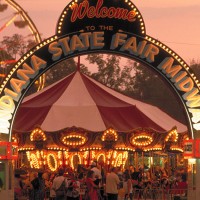
The American State Fair
Some things just seem to say “summer.” Step right up for a nostalgic look at one of America’s finest traditions.
